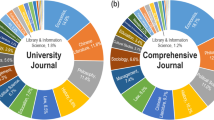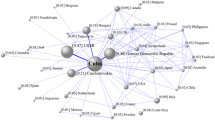Abstract
Acupuncture, the most important nonpharmacological therapy in traditional Chinese medicine, has attracted significant attention since its introduction to the Western world. This study employs bibliometric analysis to examine the profile of publication activity related to it. The data are retrieved from the database of Science Citation Index Expanded during 1980–2009, and 7,592 papers are identified for analysis. This study finds that almost 20 % of papers are published in CAM journals, and the average cited times per acupuncture paper is 8.69. While the most cited article has been cited 2,109 times, however, 38.15 % of total publications have never been cited. Europe has the largest amount of authored papers with high h-index values; the USA has the largest number of publications on and citations of acupuncture based on country distribution, and this has continued as a significant rising trend. The proportion of collaborative papers shows this upward trend on the worldwide scale while the percentage shares of national collaborations are the highest. The USA produces the most international collaborative documents, although South Korea occupies the highest percentage figure for international collaborative papers. International collaborative papers are the most frequently cited. The average number of authors per paper is 3.69 in the top eight countries/regions. Papers contributed by South Korea are authored by the most people. International collaboration papers are authored by more people, except in Taiwan. South Korea’s Kyung Hee University is ranked first in terms of number of papers while Harvard University in the USA accounts for the largest proportion of citations. The University of Exeter, Harvard University and Karolinska Institute have the highest h-index values.





Similar content being viewed by others
References
Ahn, C. B., Lee, S. J., Lee, J. C., Fossion, J. P. J., & Sant’Ana, A. (2011). A clinical pilot study comparing traditional acupuncture to combined acupuncture for treating headache, trigeminal neuralgia and retro-auricular pain in facial palsy. Journal of Acupuncture and Meridian Studies, 4(1), 29–43.
Alonso, R. N. (2011). A simple index for the high-citation tail of citation distribution to quantify research performance in countries and institutions. PLoS ONE, 6(5), 1–9.
Bishop, F. L., Barlow, F., Coghlan, B., Lee, P., & Lewith, G. T. (2011). Patients as healthcare consumers in the public and private sectors: A qualitative study of acupuncture in the UK. BMC Health Services Research, 11(1), 129.
Bishop, F. L., & Lewith, G. T. (2008). A review of psychosocial predictors of treatment outcomes: What factors might determine the clinical success of acupuncture for pain? Journal of Acupuncture and Meridian Studies, 1(1), 1–12.
Bornmann, L., Leydesdorff, L., & Van den Besselaar, P. (2010). A meta-evaluation of scientific research proposals: Different ways of comparing rejected to awarded applications. Journal of Informetrics, 4(3), 211–220.
Braun, T., Glanzel, W., & Schubert, A. (2006). A Hirsch-type index for journals. Scientometrics, 69(1), 169–173.
Danell, J. A. B., & Danell, R. (2009). Publication activity in complementary and alternative medicine. Scientometrics, 80(2), 539–551.
De Stefano, D., Giordano, G., & Vitale, M. P. (2011). Issues in the analysis of co-authorship networks. Quality and Quantity, 45(5), 1091–1107.
Dodson, G. G. (2011). Biochemical contacts and collaborations between China and the U.K. since 1911. Biochemical Society Transactions, 39(5), 1313–1322.
Evans, T. S., Lambiotte, R., & Panzarasa, P. (2011). Community structure and patterns of scientific collaboration in business and management. Scientometrics, 89(1), 381–396.
Han, J. S., & Ho, Y. S. (2011). Global trends and performances of acupuncture research. Neuroscience and Biobehavioral Reviews, 35(3), 680–687.
Hirsch, J. E. (2005). An index to quantify an individual’s scientific research output. Proceedings of the National Academy of Sciences of the United States of America, 102(46), 16569–16572.
Hopwood, V. (2003). Acupuncture. Retrieved March 10, 2011, from http://www.google.com.hk/url?sa=t&rct=j&q=University%2Bof%2BSouthampton.%2BVal%2BHOPWOOD&source=web&cd=2&ved=0CDAQFjAB&url=http%3A%2F%2Fwww.cam-research-group.co.uk%2Fpdf%2F_compmed_handouts_acupuncture.pdf&ei=mu-4TtSWNOWSiQe9vbzNBw&usg=AFQjCNEODZbC4FgG7bROC252cUtPvQtWhQ&cad=rjt.
Huang, M. H., & Chi, P. S. (2010). A comparative analysis of the application of h-index, g-index, and a-index in institutional-level research evaluation. Journal of Library and Information Studies, 8(2), 1–10.
Huang, W., Kutner, N., & Bliwise, D. L. (2009). A systematic review of the effects of acupuncture in treating insomnia. Sleep Medicine Reviews, 13(1), 73–104.
Kaptchuk, T. J. (2002). Acupuncture: Theory, efficacy, and practice. Annals of Internal Medicine, 136(5), 374–383.
Karst, M., Winterhalter, M., Muente, S., Francki, B., Hondronikos, A., Eckardt, A., et al. (2007). Auricular acupuncture for dental anxiety: A randomized controlled trial. Anesthesia and Analgesia, 104(2), 295–300.
Kvist, L. J., Hall-Lord, M. L., Rydhstroem, H., & Larsson, B. W. (2007). A randomised-controlled trial in Sweden of acupuncture and care interventions for the relief of inflammatory symptoms of the breast during lactation. Midwifery, 23(2), 184–195.
Lao, L. X., Hamilton, G. R., Fu, J. P., & Berman, B. M. (2003). Is acupuncture safe? A systematic review of case reports. Alternative Therapies in Health and Medicine, 9(1), 72–83.
Lee, A., & Chan, S. (2006). Acupuncture and anaesthesia. Best Practice & Research Clinical Anaesthesiology, 20(2), 303–314.
Lee, B. H., Zhao, R. J., Moon, J. Y., Yoon, S. S., Kim, J. A., An, H., et al. (2008). Differential involvement of GABA system in mediating behavioral and neurochemical effect of acupuncture in ethanol-withdrawn rats. Neuroscience Letters, 443(3), 213–217.
Leydesdorff, L. (2008). Caveats for the use of citation indicators in research and journal evaluations. Journal of the American Society for Information Science and Technology, 59(2), 278–287.
Leydesdorff, L., & Opthof, T. (2011). Remaining problems with the new crown indicator (MNCS) of the CWTS. Journal of Informetrics, 5(1), 224–225.
Lin, C. W. C., Haas, M., Maher, C. G., Machado, L. A. C., & van Tulder, M. W. (2011). Cost-effectiveness of general practice care for low back pain: A systematic review. European Spine Journal, 20(7), 1012–1023.
Loh, Y. L., Reilly, A., Chen, W. N., & Coeytaux, R. R. (2009). Incorporating acupuncture in a university-based family medicine center: Lessons learned. Journal of Alternative and Complementary Medicine, 15(2), 115–120.
Longhurst, J. C. (2010). Defining meridians: A modern basis of understanding. Journal of Acupuncture and Meridian Studies, 3(2), 67–74.
Lu, L., Liu, Y. L., Zhu, W. L., Shi, J., Liu, Y., Ling, W., et al. (2009). Traditional medicine in the treatment of drug addiction. American Journal of Drug and Alcohol Abuse, 35(1), 1–11.
MacPherson, H., & Schroer, S. (2007). Acupuncture as a complex intervention for depression: A consensus method to develop a standardized treatment protocol for a randomized controlled trial. Complementary Therapies in Medicine, 15(2), 92–100.
Mao, J. J., & Kapur, R. (2010). Acupuncture in primary care. Primary Care Clinics in Office Practice, 37(1), 105–117.
Martensson, L., Kvist, L. J., & Hermansson, E. (2011). A national survey of how acupuncture is currently used in midwifery care at Swedish maternity units. Midwifery, 27(1), 87–92.
Melchart, D., Weidenhammer, W., Streng, A., Reitmayr, S., Hoppe, A., Ernst, E., et al. (2004). Prospective investigation of adverse effects of acupuncture in 97733 patients. Archives of Internal Medicine, 164(1), 104–105.
Moritz, S., Liu, M. F., Rickhi, B., Xu, T. J., Paccagnan, P., & Quan, H. (2011). Reduced health resource use after acupuncture for low-back pain. Journal of Alternative and Complementary Medicine, 17(11), 1015–1019.
Navarro, A., & Martín, M. (2004). Scientific production and international collaboration in occupational health, 1992–2001. Scandinavian Journal of Work, Environment & Health, 30(3), 223–233.
Nikzad, M., Jamali, H. R., & Hariri, N. (2011). Patterns of Iranian co-authorship networks in social sciences: A comparative study. Library & Information Science Research, 33(4), 313–319.
Opthof, T., & Leydesdorff, L. (2011). A comment to the paper by Waltman et al. Scientometrics, 88(3), 1011–1016.
Pagel, P. S., & Hudetz, J. A. (2011). H-index is a sensitive indicator of academic activity in highly productive anaesthesiologists: Results of a bibliometric analysis. Acta Anaesthesiologica Scandinavica, 55(9), 1085–1089.
Peuker, E., & Gronemeyer, D. (2001). Rare but serious complications of acupuncture: Traumatic lesions. Acupuncture in Medicine Journal of the British Medical Acupuncture Society, 19(2), 103–108.
Rojas-Sola, J. I., Jorda-Albinana, B., & Criado-Herrero, E. (2009). Bibliometric analysis of Latin American, Spanish and Portuguese Scientific Publications in the subject materials science, ceramics in JCR (SCI) database (1997–2008). Boletin de la Sociedad Espanola de Ceramica y Vidrio, 48(6), 297–310.
Scheewe, S., Vogt, L., Minakawa, S., Eichmann, D., Welle, S., Stachow, R., et al. (2011). Acupuncture in children and adolescents with bronchial asthma: A randomised controlled study. Complementary Therapies in Medicine, 19(5), 239–246.
Schneider, A., Streitberger, K., & Joos, S. (2007). Acupuncture treatment in gastrointestinal disease: A systematic review. World Journal of Gastroenterology, 13(25), 3417–3424.
Sert, H., Usta, B., Muslu, B., & Gozdemir, M. (2009). Successful treatment of a resistance trigeminal neuralgia patient by acupuncture. Clinics, 64(12), 1225–1226.
Shi, Q., Xu, B., Xu, X. M., Xiao, Y. H., Wang, W., & Wang, H. S. (2011). Diversity of social ties in scientific collaboration networks. Physica A: Statistical Mechanics and its Applications, 390(23–24), 4627–4635.
Shin, B. C., Lee, M. S., Kong, J. C., Jang, I., & Park, J. J. (2009). Acupuncture for spinal cord injury survivors in Chinese literature: A systematic review. Complementary Therapies in Medicine, 17(5–6), 316–327.
Sin, S. C. J. (2011). International coauthorship and citation impact: a bibliometric study of six LIS journals, 1980–2008. Journal of the American Society for Information Science and Technology, 62(9), 1770–1783.
Takahashi, T., Sumino, H., Kanda, T., & Yamaquchi, N. (2009). Acupuncture modifies immune cells. Journal of Experimental and Clinical Medicine, 1(1), 17–22.
Thomson Reuters (2008). Using bibliometrics: A guide to evaluating research performance with citation data. Retrieved November 15, 2011, from http://WWW.science.thomsonreuters.com/m/pdfs/325133_thomson.pdf.
Thomson Reuters. (2011). Science citation index expanded—subject categories. Retrieved November 10, 2011, from http://science.thomsonreuters.com/cgi-bin/jrnlst/jlsubcatg.cgi?PC=D.
U.S. National Library of Medicine (2010). Abridged index medicus (aim or core clinical) journal titles. Retrieved November 11, 2011, from http://www.nlm.nih.gov/bsd/aim.html.
van den Besselaar, P., & Leydesdorff, L. (2009). Past performance, peer review and project selection: A case study in the social and behavioral sciences. Research Evaluation, 18(4), 273–288.
Vas, J., Aguilar, I., Perea-Milla, E., & Mendez, C. (2007). Effectiveness of acupuncture and related techniques in treating non-oncological pain in primary healthcare-an audit. Acupuncture in Medicine: Journal of the British Medical Acupuncture Society, 25(1–2), 41–46.
Venzke, L., Calvert, J. F., & Gilbertson, B. (2010). A randomized trial of acupuncture for vasomotor symptoms in post-menopausal women. Complementary Therapies in Medicine, 18(2), 59–66.
Vilke, G. M., & Wulfert, E. A. (1997). Case reports of two patients with pneumothorax following acupuncture. Journal of Emergency Medicine, 15(2), 155–157.
Waltman, L., van Eck, N. J., van Leeuwen, T. N., Visser, M. S., & van Raan, A. F. J. (2011). Towards a new crown indicator: An empirical analysis. Scientometrics, 87(3), 467–481.
Wang, S. M., ZeevN, K., & White, P. (2008). Acupuncture analgesia: I. The scientific basis. Anesthesia and Analgesia, 106(2), 602–610.
Weidenhammer, W., Streng, A., Linde, K., Hoppe, A., & Melchart, D. (2007). Acupuncture for chronic pain within the research program of 10 German health insurance funds—basic results from an observational study. Complementary Therapies in Medicine, 15(4), 238–246.
White, A., Hayhoe, S., Hart, A., & Ernst, E. (2001). Survey of adverse effects following acupuncture (SAFA): A prospective study of 32,000 consultations. Acupuncture in Medicine, 19(2), 84–92.
Widmer, M., Herren, S., Donges, A., Marian, F., & Busato, A. (2006). Complementary and conventional medicine in Switzerland: Comparing characteristics of general practitioners. ForschendeKomplementarmedizin und KlassischeNaturheilkunde, 13(4), 234–240.
Witt, C. M., & Brinkhaus, B. (2010). Efficacy, effectiveness and cost-effectiveness of acupuncture for allergic rhinitis—an overview about previous and ongoing studies. Autonomic Neuroscience-Basic & Clinica, 157(1–2), 42–45.
Wu, M. X., Li, X. H., Lin, M. N., Jia, X. R., Mu, R., Wan, W. R., et al. (2010). Clinical study on the treatment of knee osteoarthritis of shen (sic)-sui (sic) insufficiency syndrome type by electroacupuncture. Chinese Journal of Integrative Medicine, 16(4), 291–297.
Zhao, L., Guo, Y., Wang, W., & Yan, L. J. (2011). Systematic review on randomized controlled clinical trials of acupuncture therapy for neurovascular headache. Chinese Journal of Integrative Medicine, 17(8), 580–586.
Zhao, S. X., & Ye, F. Y. (2011). h-Index of high-impact hospitals. Current Science, 101(8), 984–985.
Author information
Authors and Affiliations
Corresponding author
Rights and permissions
About this article
Cite this article
Fu, JY., Zhang, X., Zhao, YH. et al. Scientific production and citation impact: a bibliometric analysis in acupuncture over three decades. Scientometrics 93, 1061–1079 (2012). https://doi.org/10.1007/s11192-012-0737-2
Received:
Published:
Issue Date:
DOI: https://doi.org/10.1007/s11192-012-0737-2




